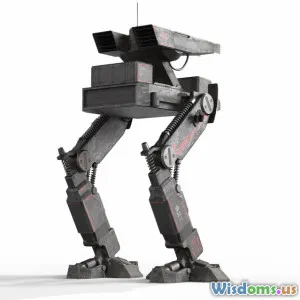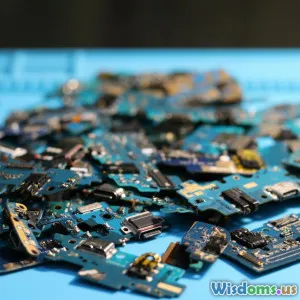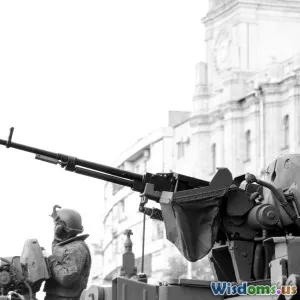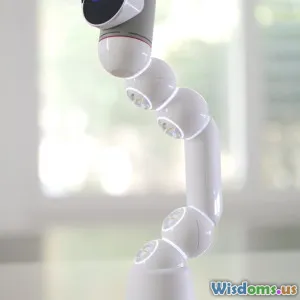
What Military Robots Can Do That Humans Cant on the Frontline
9 min read Explore how military robots surpass human capabilities on the frontline with unmatched precision, endurance, and risk mitigation. (0 Reviews)
What Military Robots Can Do That Humans Can't on the Frontline
The landscape of modern warfare is rapidly evolving, propelled by the relentless advance of technology. Among the innovations transforming battlefields, military robots stand out as game-changers capable of performing feats beyond human limits. Unlike their human counterparts, these machines operate without fatigue, can venture into hazardous environments, and execute complex tasks with exceptional precision — reshaping frontline combat in ways previously unimaginable.
Introduction
Why send soldiers to risk life and limb when robots can shoulder some of the most dangerous and demanding missions? The integration of robots in military operations isn’t merely about replacing soldiers but augmenting capabilities where human physicality, safety, and endurance are limited. Whether it’s bomb disposal, reconnaissance in inhospitable terrains, or high-speed logistics, military robots increasingly define new paradigms of tactical advantage.
In this article, we explore in detail the unique abilities that military robots possess on the frontline—what they can do that humans inherently cannot—and why this advancement is critical for the future of warfare.
Endurance Beyond Human Limits
Operating in Extreme Conditions
One of the most significant advantages of military robots is their ability to operate in environments that are lethal—or at least debilitating—to humans. Robots can be deployed in extreme heat, subzero temperatures, toxic chemical zones, or high-radiation areas with minimal risk to personnel.
Example: The QinetiQ Talon, used extensively by US military bomb disposal units, has been deployed in environments contaminated with chemical and biological agents, assessing threats and neutralizing explosives without risking human lives. This robotic versatility provides a decisive advantage in urban warfare or CBRN (chemical, biological, radiological, and nuclear) threat scenarios.
Sustained Operations Without Fatigue
Humans are limited by physical and cognitive fatigue, which can impair decision-making and reaction times under prolonged combat. In contrast, robots operate continuously under programmatic endurance parameters.
Unmanned ground vehicles (UGVs) like the Northrop Grumman Andros robot can conduct hours-long reconnaissance or complex search-and-destroy missions tirelessly. This sustained operation supports persistent battlefield awareness and reduces mission delays.
Precision and Speed in Complex Tasks
Enhanced Target Identification and Engagement
Robots equipped with advanced sensors, AI, and machine-learning algorithms can identify, track, and engage targets with superior precision and speed. Machine vision systems are less prone to distractions or emotional impulses affecting human soldiers during high-stress engagements.
Real-World Insight: The THeMIS unmanned ground vehicle can be armed remotely with various weapon systems while its AI-enabled target recognition capabilities assist in minimizing collateral damage. This precision is essential in modern asymmetrical warfare where identifying combatants versus civilians is crucial.
Rapid Decision-Making and Data Processing
Military robots process vast amounts of battlefield data in real-time, faster than any human could. This capability enables rapid adaptation to changing threat landscapes.
For instance, drones equipped with AI can scan wide areas, analyze patterns, and relay critical tactical information. A study by the U.S. Army Research Laboratory demonstrated that autonomous drones could detect enemy movements twice as fast as conventional human surveillance teams, speeding up decision cycles in high-stakes scenarios.
Risk Mitigation and Force Preservation
Reducing Casualties and Psychological Impact
Robots take on inherently dangerous missions that would otherwise expose soldiers to injury or death. Explosive ordnance disposal, scouting enemy enclaves, and breaching booby traps are classical examples where robots mitigate human risk.
Data Point: According to the RAND Corporation, integrating robots for these high-risk tasks has helped decrease service member casualties by up to 30% in certain deployments.
Moreover, using robotic systems can alleviate the psychological trauma soldiers experience during dangerous frontline missions. Knowing robots can handle the deadliest tasks may contribute to reduced combat stress and improved troop morale.
Remote and Autonomous Weapon Systems
With advancements in autonomy, military robots can engage hostiles under remote human oversight or even operate semi-independently using AI. This capability allows strategic positioning far from friendly forces while projecting power effectively.
The MQ-9 Reaper drone, for example, can execute remotely piloted strikes with laser-guided munitions from thousands of miles away, eliminating threats without putting pilots at risk.
Versatility and Adaptability in Challenging Terrains
Navigating Complex Urban and Natural Environments
Military robots are increasingly designed to traverse environments that are difficult or impossible for humans, including collapsed buildings, dense forests, underwater, and even underground tunnels.
The Boston Dynamics Spot robot demonstrates this adaptability. It can climb stairs, cross rubble, and remotely scout urban zones, providing invaluable intel in environments plagued by obstructions too risky for soldiers.
Modular Design for Multifunctional Roles
Many modern robots feature modular architecture, enabling a swift reconfiguration for different military roles—from surveillance to cargo transport or direct combat. This flexibility outpaces human multi-role capacity, which requires significant retraining and adaptation.
Example: The SMSS (Squad Mission Support System) is a robotic pack mule designed to carry heavy loads over rugged terrain, easing soldier fatigue and allowing troops to maneuver faster and longer.
Challenges and Ethical Considerations
While military robots offer remarkable advantages, their deployment raises significant operational, ethical, and legal questions. Autonomous weapon systems, responsible for lethal force application, must comply with international humanitarian laws and avoid unintended escalations. Ensuring reliable human oversight remains a critical task.
Furthermore, as robots take on more frontline roles, investing in cybersecurity to protect them from hacking or malfunction becomes paramount.
Conclusion
Military robots are not merely supplements to combat troops—they fundamentally extend the reach, precision, and endurance of warfighting capabilities beyond human limits. By enduring hostile environments, performing complex and dangerous tasks with clinical precision, and preserving lives, robots are reshaping frontline strategies.
Their continued development promises a future where war can be waged with far less human risk and greater tactical effectiveness. However, this technological leap carries with it moral and operational responsibilities that militaries worldwide must navigate carefully.
Embracing military robots today means preparing for a battlefield tomorrow increasingly defined by man-machine collaboration, where the line between human capability and robotic prowess blurs in service of security and survival.
References:
- RAND Corporation: "Military Robotics and Combat Casualty Reduction" (2019)
- U.S. Army Research Laboratory studies on autonomous drone surveillance (2021)
- QinetiQ Talon operational histories
- Boston Dynamics Spot user deployment reports
- Khalilzad, Z. "Ethics and Future of Military Autonomous Systems" (2022)
Published under Military Technology & Future Weapons
Rate the Post
User Reviews
Popular Posts




















